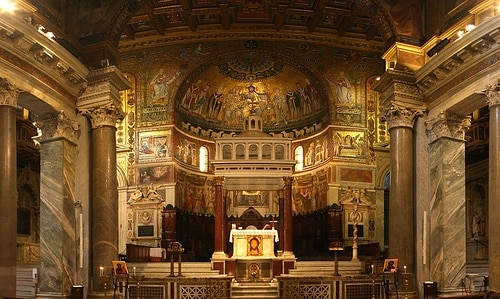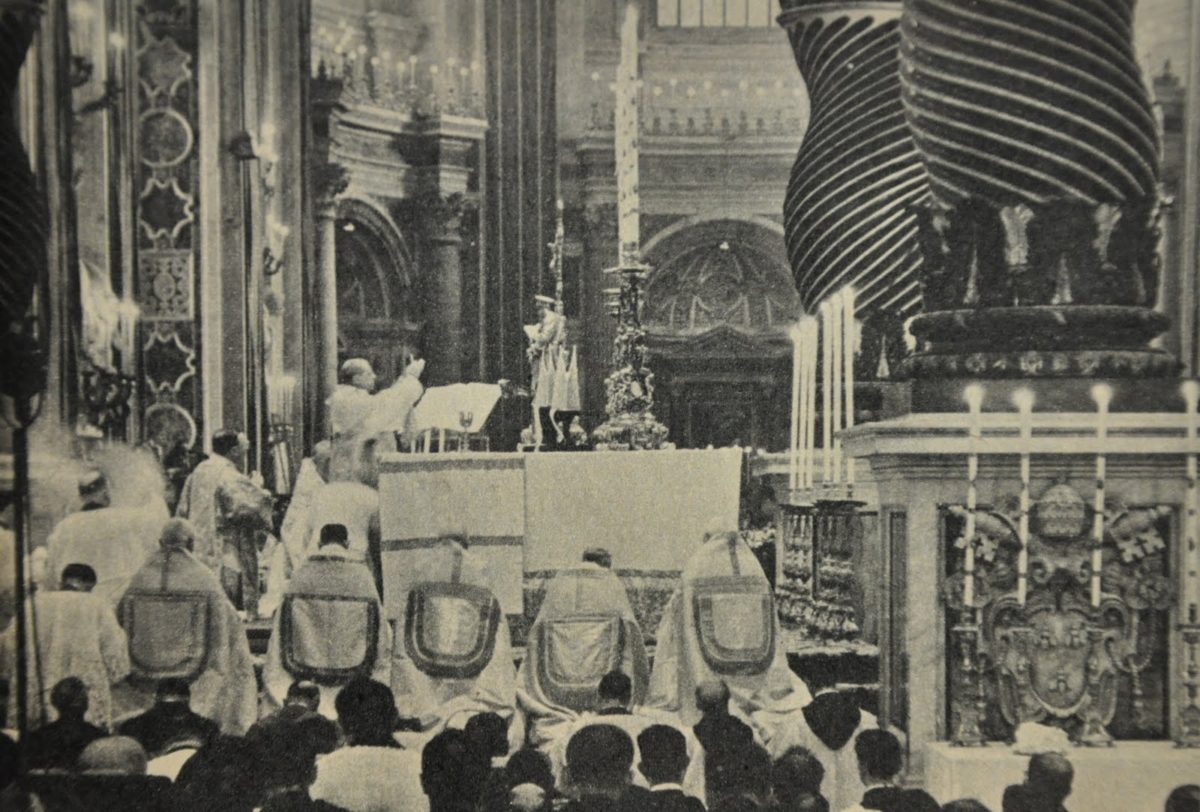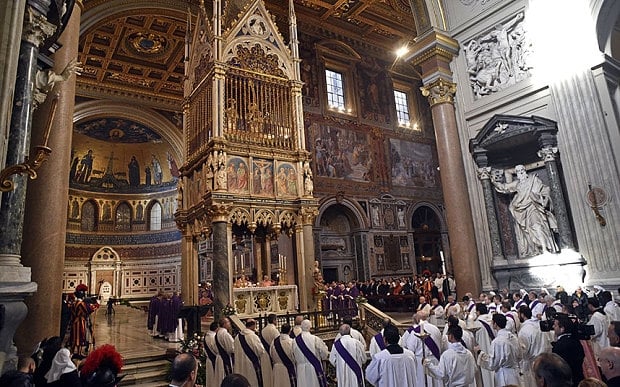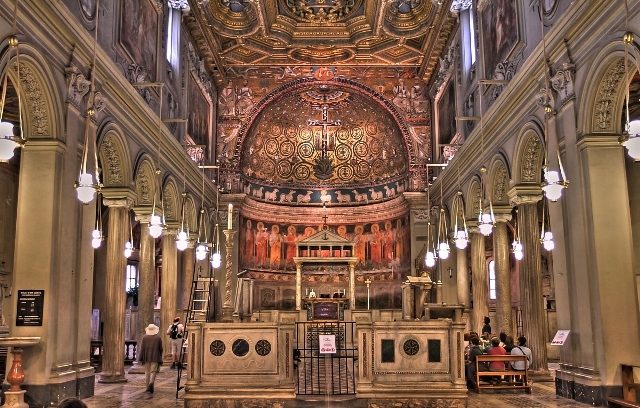Which is MORE Traditional: Mass ad orientem or versus populum?
Ever since Cardinal Sarah’s ad orientem endorsement, and subsequent slap down by voices in the Holy See, there is debate on both sides favoring ad orientem celebration of the Holy Mass.
My goal here is show that both ad orientem AND versus populum are part of the ancient Roman Rite – and to show how the ciborium/baldacchino is a determining factor in the architecture governing each. Before we get started, let’s define vocab and issue a clarification to the liturgical police on each extreme:
Defining Terms of the Debate
ad orientem: Latin for “to the East.” For those new to the debate, ad orientem refers to the priest celebrating Mass on the same side of the altar as the people. People wrongfully call this “priest with his back to the people.”
versus populum: Latin for “toward the people.” This refers to the priest celebrating Mass on the opposite side of altar so that he is facing the people in the nave.
ad Deum: People wrongfully use ad Deum (Latin for “toward God”) as a synonym for ad orientem. I dislike this usage because it’s confusing and it presumes that versus populum is not ad Deum or “toward God.” When Pope Boniface VIII celebrated Holy Mass in AD 1300 at Old Saint Peter’s Basilica versus populum, he was celebrating Mass ad Deum (to God). It’s blasphemous to say otherwise. A valid Mass is always ad Deum no matter where the priest stands.
ciborium: Usually this refers to the precious vessel that holds the hosts during Mass. It can also roofed baldacchino that stands over the altar.
Showing My Liturgical Preference Cards Up Front
When writing about liturgy, everyone wants to size you up and classify you: Is he trad, is he liberal, is he reform-of-the-reform, whatever. So here is my perspective. I prefer the EF Latin Mass and I’m a member of a FSSP parish. But I attend the so-called Novus Ordo for daily Mass – and I usually attend the Novus Ordo when I travel. I have attended the Novus Ordo in Saint Peter’s Rome. I’ve attended the EF Latin Mass in Saint Peter’s in Rome. I received Jesus Christ and for this I’m grateful.
I can serve the EF. I’m good at Latin and I understand most of it in the Mass. I can listen to the Epistle and Gospel in Latin and understand it.
I love ad orientem. I find priests smiling over the altar as distracting. Personally, I find the priest facing with the congregation more Christocentric. For me, the elevation is more dramatic and devltional ad orientem. Silent canon makes more sense ad orientem, in my opinion. All pluses from my point of view.
Conclusion: I like the Latin Mass, but I never make a stink of it. I’m not exclusivist.
Talking Latin Mass Will Always Get You Judged…
I almost hate writing about anything Latin Mass because it gets me labeled by both extremes in the Church. So let me just issue a clarification:
For liturgical progressives who want to judge me: I don’t believe that attending the EF Latin Mass is a statement or that it means that one is “rad trad” or hates his local bishop or the Pope. Far from it. I love the Ordinary Form of the Mass. I attend it daily. I love my local bishop and pray for him daily. I love the Holy Father and pray for him daily and was even honored to shake his hand recently when he kissed my baby. I know that these hostile elements can exist in the “trad movement” but I’m not into that. So if you want to lump me in with the “mean Latin Mass haters,” you’re wrong.
For Traddies who want to judge me: I don’t think that Latin EF Mass and ad orientem is divinely mandated liturgy, nor do I think it’s always the best. If you think for saying this, I’m a Freemason, heretic, idolator, New World Order-ist, Novus Ordo-ist, Neo-Catholic – you’re incorrect and I’ll ignore your comments.
Both Versus Populum and Ad Orientem in the Roman Tradition
I just got back from Rome. If you’ve been there, you know already that the major churches in Rome have always had the priest facing the people over the altar (photos at the end of the post):
- St Peter’s
- St Paul’s outside the Walls
- St John Lateran
- St Mary Major
- St Clement’s
- St Maria in Trastavere
Why? Because versus populum was part of the ancient Roman tradition. Where there was space and a big budget (as in these important Roman churches), they worked it versus populum. However, this elegant arrangement usually requires the presence of a ciborium (a stone canopy or baldacchino) over the altar.

Where there isn’t space to do it right (that is, no ciborium over altar), they worked ad orientem with dignity.
Those that study the issue know that it has to do with whether a Roman ciborium/baldacchino can be built over the altar. Generally speaking, if there is a ciborium, it’s versus populum. If not, there’s ad orientem.
There is a Roman way of doing versus populum and Pope Benedict pointed that out: screens and/or baldacchino, candles on the altar (causing visual disruption), and especially a crucifix in the middle. The silent canon especially balances out versus populum and the attention on the priest.
My personal preference would be that everything should be ad orientem – unless you can install a ciborium/baldacchino over the altar – ideally with a sunken confessio for relics under the altar. If not, it should be ad orientem.
The problem, in my unimportant layman’s point of view, is that parishes in the 1950s-1980s plunged into versus populum altars without understanding the ancient Roman requisites for such people-facing altars. So now we have a churches where the altar lacks dignity and is often dwarfed by “the presiders chair” and the ambo. The ciborium canopy magnified the dignity of the altar within the versus populum context. We need to rediscover this feature of Roman liturgy and architecture. We need to start building a ciborium canopy over the altar.
Photos of Examples of Versus Populum with Proper Ciborium
Here are photos of the churches above showing how the ancient Roman versus populum worked with the ciborium canopy or baldacchino:
Here’s Pope Pius XII celebrating versus populum…but under the baldacchino with candle and crucifix “obstruction.”

Here’s the Pope’s cathedral Saint John Lateran. Note the amazing baldacchino which contains the skulls of Saint Paul and Saint Peter behind the gold grating above the altar:

Here’s my favorite church Santa Maria in Trastevere in Rome. Historic versus populum, but with a baldacchino. This church is so God-honoring. Beauty. Truth. Goodness. I try to attend Sunday Mass here (Ordinary Form) whenever I can:

And here’s San Clemente in Rome. Small church with versus populum with a modest baldacchino:

I could also include Saint Mary Major and Saint Paul’s outside the Walls. The point is, if you’re going to do versus populum, you need a baldacchino/ciborium over the altar. If not, ad orientem tends to be the “traditional” way to construct a church.
Comments
[reminder]I’d love to hear your thoughts and comments. Do you have a preference? How is your parish set up? Do you like it or not? How could we improve our altars using the Roman churches as models?[/reminder]
Dive Deeper

GET CONFIDENT IN YOUR FAITH
Explore the fascinating world of Catholic teachings with Dr. Marshall. Together you’ll unpack the brilliant answers the Church gives to tough questions about the Faith. The best part: you go at your own pace. Start this exciting journey today.
